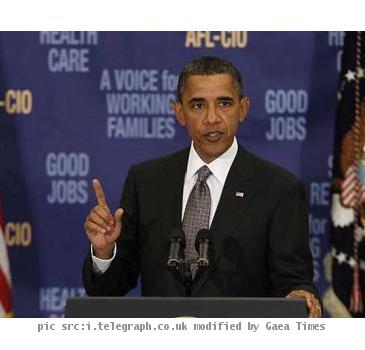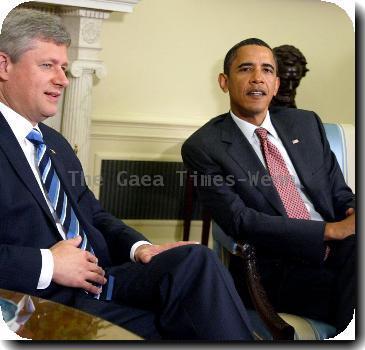5 years after Katrina, residents mourn dead and celebrate region’s recovery, not yet complete
By Michael Kunzelman, APSunday, August 29, 2010
5 years after Katrina, a revival not yet complete
NEW ORLEANS — Gulf Coast residents tried to put Hurricane Katrina behind them on Sunday, marking its fifth anniversary by casting wreaths into the water to remember the hundreds killed. But part of the catastrophe lives on, in abandoned homes still bearing spray-painted circles indicating they had been searched and whether bodies were found inside.
President Barack Obama joined those hailing the recovery made so far in New Orleans, which he said has become a “symbol of resilience and community.” In a neighborhood that has seen little of that recovery, the Lower 9th Ward, it was the failures that seemed more apparent to residents.
“It don’t seem like much is getting done,” said Charlene LaFrance, a 42-year-old teacher who watched commemoration events on Claiborne Avenue. Brass bands played dirges and marches and politicians spoke about the nation’s failure to do enough to rebuild New Orleans, in particular the Lower 9th Ward.
The neighborhood, down river from the French Quarter, was devastated when the floodwall on the Industrial Canal toppled over and unleashed a wall of water that knocked scores of homes off their foundations. Many of the more than 1,800 people killed by Katrina died in the Lower 9th Ward, and only about a quarter of the 5,400 homes there before the storm have been rebuilt.
“This is hallowed ground now,” said Marc Morial, a former New Orleans mayor and the president of the National Urban League.
He told a jubilant crowd that the Lower 9th Ward can be rebuilt. “All it needs is decent, strong levees that don’t break.”
The Army Corps of Engineers is nearing completion on a levee system for New Orleans that the agency says should be able to withstand a Katrina-like storm once it is finished next summer. The Lower 9th Ward is now protected by a massive, dam-like structure.
Obama, speaking at Xavier University, cited progress made in the recovery but added that there are still too many vacant lots, too many people unemployed and “too many New Orleanians who have not been able to come home.” The recession and the Gulf oil spill have made it even tougher for the area to bounce back, he said.
“My administration is going to stand with you and fight alongside you until the job is done,” Obama pledged.
Ceremonies also were held in Mississippi, where at least 175 people were killed by the storm. In Biloxi, U.S. Rep. Gene Taylor compared the Gulf Coast to the area’s oak trees — scarred by the storm but strong enough to survive.
At a marble wall in Shell Beach, La., honoring the 163 people killed in coastal St. Bernard Parish, more than 100 people braved Sunday’s soggy weather as parish officials read aloud the victims’ names.
Diane Phillips, who lost two cousins and several friends in the storm, volunteered to lay a wreath in the bayou. Some wiped away tears as the wreath floated away.
“You think of the whole entire parish and everything that we lost that day and everything that we’ve brought back since then,” said Phillips, 51, of Hopedale.
Gladys Nunez and Linda Wells didn’t know each other before the ceremony — but both knew many of those whose names are etched in the memorial. Nunez wrapped her arm around Wells, who was visiting the site for the first time.
“I had to come see for myself and try to put this behind me,” said Wells, 50, of Chalmette.
Nunez, 68, of Toca, said: “It’s something we’ll live with for the rest of our life. It never goes away. Katrina showed no mercy.”
Members of First Grace United Methodist Church in mid-city New Orleans celebrated the city’s renewal. Church membership, once down to 50 people, now stands at 180, Pastor Shawn Moses Anglim said.
“After every flood, there is going to be a rainbow,” he said.
Church member Martha Ward, a 69-year-old anthropologist at the University of New Orleans, told the congregation that Katrina and the ensuing evacuation are the reason she married her longtime boyfriend.
“This church is a miracle. It’s the face of New Orleans,” she said, referring to the multicultural congregation that attends the church.
In the Lower 9th Ward, a parade marched to the top of a large rusty bridge over the Industrial Canal, where a wreath was thrown in honor of the dead.
Alan Drake, a 57-year-old engineer who joined the march in solidarity, lives in the Lower Garden District, a neighborhood on the “sliver by the river” that did not flood.
“We are finally past the part of major rebuilding in large parts of the city,” Drake said. “But we’re certainly not over the hump here.”
Since Katrina struck on Aug. 29, 2005, the Lower 9th Ward has seen thousands of volunteers help gut homes, clean up yards and rebuild homes and businesses. It also has become the focal point in an effort since Katrina to make the city more eco-friendly. Groups like Global Green USA, the Sierra Club and movie star Brad Pitt have helped make the Lower 9th Ward into a greener neighborhood. A new eco-friendly village is sprouting near the Industrial Canal floodwall that broke and there are several groups making the Lower 9th Ward the focus of environmental plans. Recently, a plan was announced to build a community center, using U.S. Department of Energy funds, in the neighborhood where people can also learn about climate change.
But government aid has been limited. In many cases, residents were left out of rebuilding grants and other programs to help people rebuild. Some of the problems stemmed from a lack of flood insurance, small payouts from insurers, difficulties in establishing ownership of property and fears of more flooding.
LaFrance, the teacher, said her family was able to rebuild in the Lower 9th Ward, but that too many homes remain untouched and are falling apart.
“Blighted property right next door, that’s what I don’t enjoy,” she said. “I got grandchildren. They need to demolish those homes.”
She said the neighborhood, which she said was a family-oriented place before Katrina destroyed it, can barely be called a neighborhood. There are few businesses now, “No local restaurant where you can wine and dine in the Lower 9,” LaFrance said, shaking her head.
Kunzelman reported from Shell Beach, La. Associated Press Writer Erica Werner contributed to this report.
Tags: Barack Obama, Coastlines And Beaches, Louisiana, New Orleans, North America, United States

